For years now, the accepted March birthstone has been beautiful blue aquamarine. It wasn’t always that way, however. Many years ago the birthstone for March was determined by where you were from since each society had their own thoughts on what gemstones they associated with certain months. In ancient times, for instance, bloodstone was associated with March in a Gregorian poem of unknown origin:
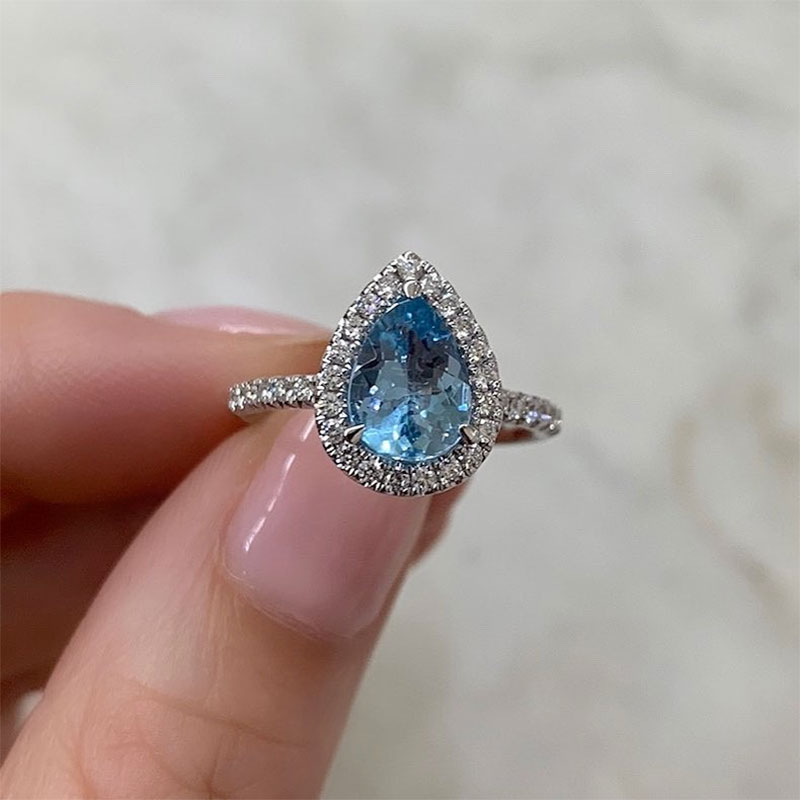
“By her who in March was born.
No gem save bloodstone shall be worn.
They will ensure her constancy.
True friendship and fidelity.”
How Aquamarine Became the Birthstone for March
The modern birthstone of March, aquamarine, was designated in 1912 when the trade association Jewelers of America circulated a list that they had prepared for jewelry retailers to use in order to promote birthstone jewelry to their customers. Much of the confusion about which stone two associate with which month went away after this list was circulated, and the modern birthstone list quickly became the definitive authority for birthstones.

As for having a beautiful birthstone, March babies certainly lucked out. The aquamarine gemstone is not rare by any means, and it is one of the “semi-precious” gemstones, taking its place by such other stones such as the beautiful February birthstone amethyst, Tanzanite, and peridot. Aquamarine is a close relative of the emerald, being a form of the mineral Beryl. Aquamarine gets its color from iron, while emeralds get their color from vanadium and corundum.
The best aquamarine stones tend to be a beautiful deep blue, green color, but many beautiful aquamarines are found in lighter blue colors also. If you would like to make sure you are getting the best aquamarine available, look for stones coming from Brazil or Mozambique. The aquamarine gemstones found in those two areas tend to be larger and more clear than those found in other areas. Aquamarine stones have a tendency to appear dichroic, which means that when they are viewed from different angles in different types of light, they appear to change color.
Some Unique Characteristics About the March Birthstone You Should Know
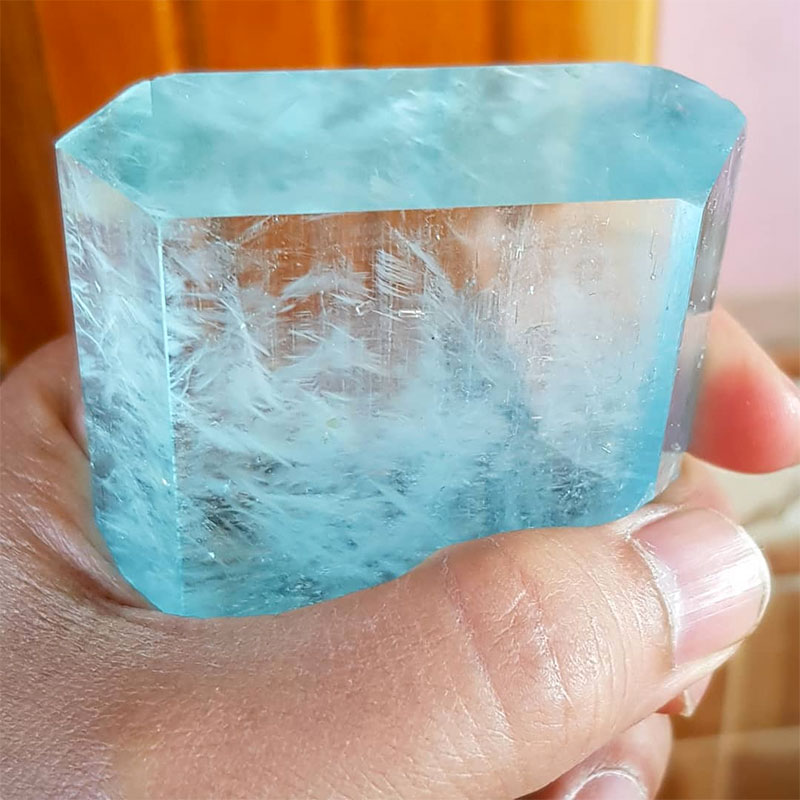
- Because of their internal structure, aquamarines are prone to developing internal cracks if the stone is struck sharply by a hard object. Always make sure to remove aquamarine jewelry before doing tasks such as housework, dishwashing, or engaging in sports. I can attest to this personally. An aquamarine ring I inherited after my mother’s passing was cracked when it struck the inside of my washing machine one day while I was removing clothing from the machine. Be very careful with aquamarines, especially if they are in jewelry that is extra special to you!
- Aquamarine gemstones, when exposed continuously to sunlight, may fade. This is another good reason why aquamarine jewelry should be removed when playing outdoor sports.
- Aquamarines tend to attract and hold dirt such as lotions skin oils and soap, so regular cleaning is usually needed. The easy way to clean aquamarine jewelry is to use a soft old toothbrush which has been sanitized in a dishwasher, and warm soapy water. The jewelry should be dipped in the soapy water and lightly scrubbed with the brush, and then rinse thoroughly and dried with a soft cloth.
Popular types of March birthstone jewelry are aquamarine rings, pendants, and earrings. Many wonderful online retailers sell aquamarine jewelry, which tends to be moderately priced. Of course, it depends on what other elements have been paired with the aquamarine gemstones such as gold settings and diamond accents. Even so, some very good prices can still be found for March birthstone jewelry such as this beautiful 10k White Gold, March Birthstone Aquamarine and Diamond Ring that can be found at Amazon.com.
Aquamarine, the birthstone for March, certainly is a gorgeous gemstone. If you were born in March, you certainly should treat yourself to at least one piece of aquamarine jewelry. Come to think of it, even if you were not lucky enough to be born in March, you should still treat yourself to at least one piece of beautiful blue aquamarine jewelry!
Before You Buy – Helpful Information About Aquamarine
Aquamarine can be one of the more valuable semi-precious gemstones. However, because aquamarine has such a wide range of prices, it’s important to understand exactly what you’re buying before you do. An aquamarine gemstone could cost you anywhere from $200 to $2,500, so you’ll want to do your research. This in-depth guide will walk you through the March birthstone with a focus on the stone’s origins, history, quality factors, and value.
1. Aquamarine Definition
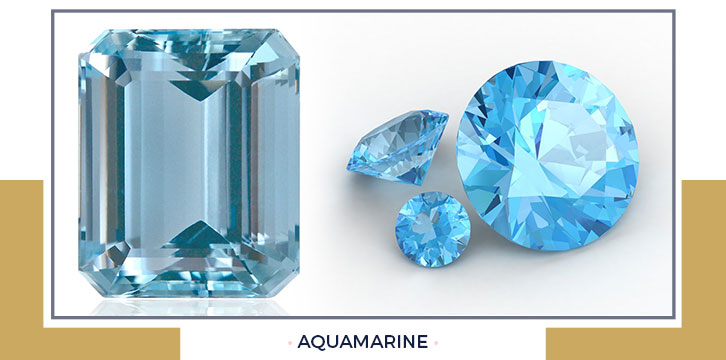
What is Aquamarine?
Aquamarine is a pale greenish blue member of the beryl family. It is March’s birthstone and gets its calming color from trace amounts of iron. Other members of the beryl family include emerald and morganite.
Aquamarine’s chemical formula is Be3Al2SiO6, which is a combination of beryllium and aluminum silicate. It’s a very durable gemstone and ranks between 7.5-8.0 on the Mohs Scale of Hardness.
Where is Aquamarine Found?
Beryl deposits have been found all over the world, but high-quality aquamarine is mined primarily in Brazil, Nigeria, Mozambique, Pakistan, and Madagascar.
Shop Loose Aquamarine Gemstones on Amazon >>
2. Aquamarine History
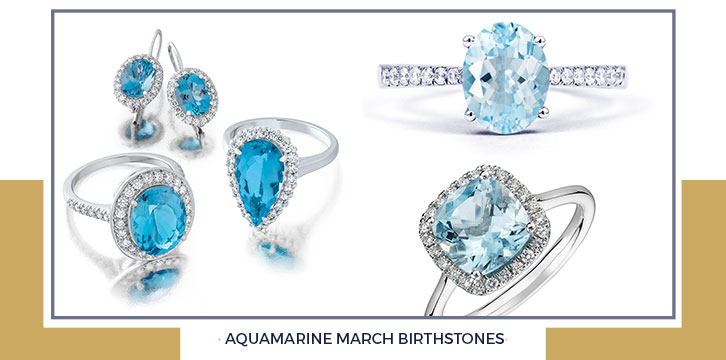
Aquamarine Name Origins
Aquamarine has been used in jewelry for centuries and has long been associated with the sea. The name aquamarine comes from the Latin aqua marīna which translates as sea water. The correlation comes not only from the gems sea-like color but the incredible transparency of the crystal. Aquamarine can be and often is as clear as a glass of water.
Crystal Meaning and Lore
Neptune, the Roman God of the Sea, and Poseidon, the Greek God of the Sea, were both strongly linked to aquamarine throughout ancient history. Their likenesses were carved into amulets and given to sailors because it was thought that wearing aquamarine would offer sailors safe passage through tumultuous seas.
Symbolism
Aquamarine’s symbolism goes far beyond the sea. The tranquil gem symbolizes friendship, courage, and honesty. The birthstone for March is also associated with the zodiac sign, Scorpio.
Wearing an aquamarine crystal is believed to aid in a happy marriage and enhance the intellect.
Healing Properties
Aquamarine is used heavily in chakra healing and is linked to the heart, throat, and third eye chakra. The stone aids in meditation by clearing the mind and calming our emotions while also improving our intuition. By keeping our thoughts and emotions steady, aquamarine plays an integral role in crystal healing.
The cooling properties of aquamarine are thought to aid in the healing of infection, inflammation, and an overactive nervous system. Are you a nervous nellie? Consider wearing a strand of natural aquamarine beads around your neck.
Famous Aquamarine Gemstones
Even though aquamarine is not considered a precious gemstone, it has played a feature role in some very high-end designer pieces from the likes of Tiffany & Co and Cartier. Rene Lalique, who is one of my favorite Art Nouveau designers, also favored the pale blue jewel in his designs, like in his famous Thistle corsage ornament centered with an intense aquamarine gemstone and flanked with molded glass, enamel, and diamonds.
The largest aquamarine specimen ever found can’t even be realistically measured in carats, unless you want to count into the hundreds of thousands. It was discovered in Brazil in 1910 and weighs a staggering 244 pounds! This stone is not only massive, it is also near flawless and of gem-quality.
The Dom Pedro aquamarine is the largest cut and carved aquamarine gem, and it is magnificent. The 10,363-carat sculpture stands an impressive 14 inches tall. The famous stone was mined in Brazil in the late 1980’s and is named after Brazil’s first two emperors. Check out the image above for a close up look at the intriguing gem on display at the Smithsonian’s Museum of Natural History.
Most famous aquamarines are famous for both their color and their size. One of my favorites is the aquamarine made famous by First Lady, Eleanor Roosevelt. The stone is an enchanting blueish-green aquamarine that weighs 1,298 carats. It is one of the largest, if not the largest, step cut stone in the world. The stone was given to the first lady when she and President Franklin D. Roosevelt visited Brazil in 1936 as part of the “Good Neighbor” cruise in South America.
Mysterious Maxixe Beryl
There is a very deep variety of beryl that resembles the color of a sapphire. This stone has a blue color when found and cut, but after prolonged exposure to the sun, the blue tone completely disappears and turns to a light yellowish green. Some companies have tried treating this stone and selling it as aquamarine, but the color is still relatively unstable. If you happen to own or wish to buy a Maxixe beryl, do your best to keep the stone out of strong sunlight.
3. Aquamarine Value and Quality Factors

Semi-Precious vs. Precious
Aquamarine is a semi-precious gemstone but can be as valuable as a precious gemstone under the right conditions. It is more expensive than blue topaz, another similarly colored birthstone, due to its rarity and popularity. Aquamarine’s price varies from very affordable to very expensive depending on a number of factors.
Inclusions
Though aquamarine can have thin, needle-like inclusions, most aquamarine on the fine jewelry market is clear and eye clean. Aquamarine does have a heavily included, opaque version, and these are usually carved into cabochons, beads, or other shapes.
Aquamarine’s inclusions tend to run parallel to one another in long, thin lines. In rare form, some aquamarine stones have so many of these inclusions that they can display a cat’s-eye effect.
Color
Unlike many other gemstones, the color of aquamarine is very limited. Colors range from a pale seafoam green to a deep mid-toned ocean blue, the latter being the more valuable color. Color zoning is rare for this gemstone, so it doesn’t play into the value as much as it would for sapphire, which has much more potential for undesirable color zoning.
In the next section, you will learn more about aquamarine treatments. For now, know that pale baby blue stones and lighter colored seafoam green stones are similar in price even though one has been treated and one has not.
Carat
Carat sizes on aquamarine can commonly be found above 10 carats, which makes aquamarine a versatile option for larger scaled designs. The larger the aquamarine, the more likely it is to have a deep, desirable color.
Small stones under 5 carats tend to be very faded looking and can often look like clear topaz with a very slight blue tinge. However, there are some mines that produce smaller stones that have a natural, intense color. These stones may cost significantly more per carat than a larger, more faded aquamarine. The most important factor then is color and not carat.
Cut
As we went over in the inclusions section, aquamarine is usually clear but does come in a variety of clarity grades. Heavily included and opaque stones are generally cut into cabochon shapes or carved into intricate designs. Smaller, transparent stones are usually cut into ovals, and larger, transparent stones are usually cut into emerald cuts. However, unlike some colored stones, there is no underlying cut that the stone is usually shaped into. Eye-clean stones have the ability to be cut into kites, marquise, hearts, and any other fancy cut so long as there are no major inclusions that would compromise the overall stability.
Expert Tip: Since aquamarine is durable enough for everyday wear, pale colored aquamarine can be an excellent alternative for an engagement ring for couples on a budget. The pale blue adds a little personality while saving you tons of money. Just be sure you aren’t purchasing “colorless aquamarine.” Completely clear stones with no blue tint are considered clear beryl and are not aquamarine.
4. Aquamarine Treatments and Synthetics
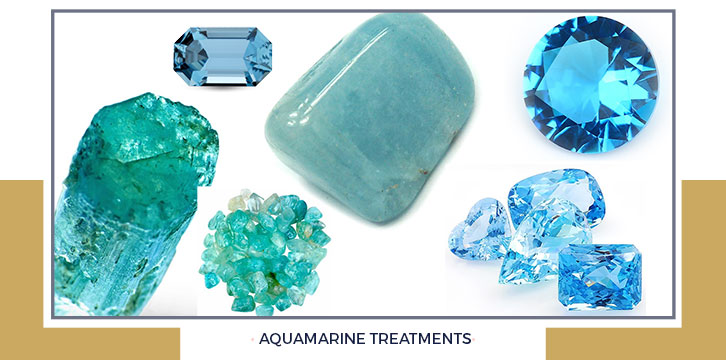
Aquamarine is often heat treated to remove any green tones, which makes the gem a more pure blue color. This is done because natural aquamarine is more valuable when the tone is pure blue. However, some people like myself actually prefer aquamarine that has more green undertones.
There is no known synthetic version of aquamarine. However, there are many simulated aquamarines on the market you should be aware of.
Simulated Aquamarine
The main difference between a synthetic stone and a simulated one is that synthetics are exact manmade counterparts of a gemstone. A simulated stone does not have the same chemical composition but is made of a different material altogether. The final product is made to look like the natural gemstone, sometimes in a deceptive way. Some examples of simulated aquamarine include colored glass or crystal, synthetic corundum, blue zircon, and even some blue topaz could be considered a simulated version of a more expensive aquamarine stone.
Expert Tip: Blue topaz is sometimes be referred to as “Brazilian Aquamarine.” Blue zircon is sometimes referred to as “Siam Aquamarine.” These are simulated aquamarine gemstones and are not natural or even synthetic aquamarine.
5. Shop for Aquamarine

Aquamarine can be found in both high-end designer jewelry and lower-end costume jewelry due to the wide range of qualities on the market.
If you’re going to invest in an aquamarine gemstone for your jewelry collection, I suggest seeking out a stone that is unusual in some way. Maybe it’s a different shape than the classic oval or emerald cut. Maybe there are a ton of inclusions, or maybe it has a very prominent seafoam green color. Another way to invest in aquamarine is to buy an antique or vintage piece. You can find some really pretty aquamarine stones from the 1920’s, but buyer beware. They used a lot of simulated stones during this era.
Even though the trend in the commercial fine jewelry market is on faint, pure powdery blue aquamarines, that trend won’t last forever, so think outside the box and find a stone that speaks to you, not the market.
Shop the Ring in the Photo on Amazon: Emerald-Cut Aquamarine and Green Sapphire Statement Ring

 Haute Couture Emerald Statement Earrings
Haute Couture Emerald Statement Earrings